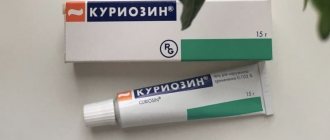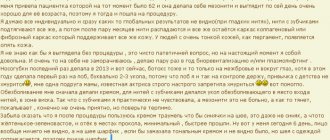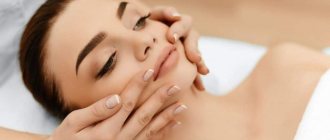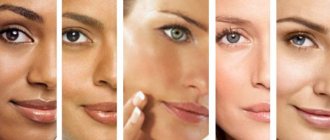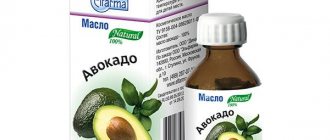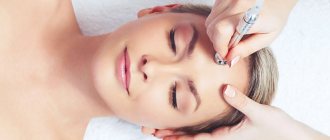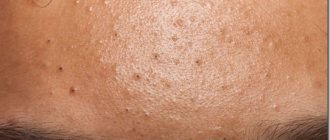Until recently, the age of 50 for a woman was considered pre-retirement, and at 60 all that was left was to nurse grandchildren and grow flowers in the country. Modern 50-60 year old ladies are completely different: they reap the benefits of career achievements, have many hobbies outside of work and are not going to give up their personal lives and hobbies. And, of course, they want their external appearance to be in harmony with their inner world.
On the other hand, not every woman, even in adulthood, is ready to decide on rejuvenation surgery. Some people are afraid of surgery in itself, others are afraid of the need for recovery, and still others are afraid of harm to their health from anesthesia. For those who take care of themselves, but are not ready for radical measures, there are conservative methods of facial rejuvenation that allow you to look decent at any age. One of the newest promising technologies for rejuvenating an older face, which has virtually no contraindications, is thread implantation.
What are facial threads and how do they work?
The technology of implanting gold threads under the skin of the face appeared at the end of the last century. They were intended to correct the first age-related changes in relatively young women 30-35 years old. Nowadays, gold threads are used much less frequently. They were replaced by completely inert absorbable materials, which gave a new impetus to technology: modern threads make it possible not only to reinforce tissue, creating a durable frame. but also to move them, tighten them, which is especially important for facial rejuvenation after 50 years - and, even more so, for correcting facial changes after 60 years.
For thread lifting, or, as it is often called, thread lifting (the English word “thread” means “thread”), threads made of polydioxanone, polylactic acid, and caprolactone are used. For quite a long time they served as the basis for surgical suture material and their hypoallergenicity and safety are beyond doubt.
Once under the skin, the threads form an aseptic (microbial-free) inflammation around themselves. At the same time, many biologically active substances are released into the tissue, which dilate blood vessels, improve microcirculation and activate cells that synthesize collagen and elastin - proteins that give the skin strength, firmness and elasticity. A collagen capsule is gradually formed around the thread, which tightens the skin. This capsule remains even after the thread itself has dissolved. This creates a natural frame that resists age-related changes.
What are the contraindications?
There are a number of contraindications, the presence of which prohibits the use of this facial rejuvenation technique. Among them are:
- pregnancy and lactation;
- allergic reaction to anesthesia or components of suture material;
- diseases of the blood (clotting disorders) and blood vessels;
- diabetes;
- presence of cancer and autoimmune diseases;
- acute viral infections;
- inflammation;
- pronounced ptosis (drooping) of tissues;
- inflated patient expectations.
In all other cases, if there are indications, you can safely carry out the procedure.
What threads can there be and who are they best suited for?
Threads for facial rejuvenation can be smooth and structured (braided, spiral or notched). Which threads to use depends on the characteristics of the face and the tasks of the cosmetologist.
Smooth threads provide rejuvenation and biorevitalization of the face. Due to the mechanisms described above, the skin smoothes out, becomes more toned and fresh. But for a facelift after 50 years, this is usually not enough, because by adulthood, not only the density and elasticity of the skin usually changes: fatty tissue is also redistributed, gradually “sliding” into the lower third of the face. Therefore, smooth threads after 50 with a single use can cause a noticeable effect in women with fine-wrinkled aging. With this type of face, after 50 years, subcutaneous fat is moderately expressed and does not “tend” down: thin, dry skin forms a network of wrinkles, but there is no double chin or “jowls” (sagging cheeks). After the introduction of threads and the formation of a collagen framework, wrinkles are smoothed out, providing a noticeable rejuvenation effect. however, it will develop gradually - the first changes appear no earlier than 2-4 weeks and intensify within 4 months - six months.
Get an online consultation
right now.
Get
With the deformation type of aging, when there are relatively few wrinkles, but the skin clearly loses its elasticity and the tissues begin to sag, smooth threads for the face after 50 can become the first stage of rejuvenation. They help restore elasticity to the skin, after which barbed threads are implanted to move and hold the tissue. Or the doctor immediately applies structured threads, if the skin condition allows. Only a specialist should decide which threads to use for a particular person.
The method of administration may also be different: most often the doctor forms a mesh frame under the skin, but there are techniques (they are especially relevant for facial rejuvenation after 60 years) when the ends of the threads are fixed to bones or fascia, strong connective tissue formations. For example, by “tightening” the tissues of the lower third of the face, the doctor can attach the ends of the threads to the bone behind the ear. This type of lifting is more traumatic and painful, but the result becomes noticeable immediately after the intervention, improving over time. The effect after thread lifting lasts 2-3 years.
The manipulation is carried out under local anesthesia, with the exception of techniques that require fixation of threads.
At what age should threads be used for facial rejuvenation? Most cosmetologists agree on 35-40 years as the optimal age for the first procedures. But, of course, you can use thread lifting for the face after 50 and even 60 years. True, procedures for facial rejuvenation after 60 years require an integrated approach, which we will talk about now.
Use of anesthesia
Thread lifting is performed under local anesthesia. If barbed threads are used, infiltration anesthesia of the area may be required. In this case, dental painkillers are first injected into the area of intended correction. When lifting with smooth threads (for example, mesothreads), a special anesthetic cream is applied to the surface of the correction area.
Minor pain may occur after the anesthesia wears off, but this pain is quite tolerable. Patients with a low sensitivity threshold are recommended to take painkillers in the first few days.
Threads for facial rejuvenation after 60 years
Amateurs, speaking about the work of a specialist in the field of aesthetic medicine, often complain: they say, a person comes with one problem (for example, wrinkles around the eyes), and several more are imposed on him (loss of skin tone, redistribution of subcutaneous tissue. But aging does not occur simultaneously and is exciting all areas of the face. Therefore, when solving the problem of facial rejuvenation after 60 years, it is necessary to take into account the whole complex of age-related changes. This includes a slowdown in the production of collagen and elastin, as a result - reduced skin elasticity and wrinkles. This also reduces the number of capillaries of the skin, which is poorly “nourished” , which means it loses its healthy color and is renewed worse. Fat deposits are redistributed: the eyes “sink”, the cheeks become smaller. The tone of the muscles changes: the depressor muscles are activated: the lowering eyebrows (and creating a horizontal wrinkle on the bridge of the nose), the lowering corners of the mouth. And the muscles - The levators (raising the eyebrows, corners of the mouth, eyelids), on the contrary, relax. Even the bones change, decreasing in volume (resorbing). And for rejuvenation after 60 years, it is not enough to just “inject” the eyes with botulinum toxin or just “correct” the cheekbones with contour fillers. Such interference will make the face unnatural. In order for the changes to look harmonious, at the age of sixty, along with thread lifting, both fillers and Botox are necessary, but the effect has to be on the entire face, and not just on certain areas.
There is one more nuance: at the age of sixty, the regenerative abilities of tissues decrease. Therefore, many techniques designed only to activate metabolic processes reduce their effectiveness. And if smooth threads for the face at the age of 50 can be used under certain conditions as an independent procedure, then at sixty one revitalization effect alone will clearly not be enough.
Botulinum toxin helps reduce hypertonicity of the muscles that give the face a “tired” expression, and reduce the depth of facial wrinkles. Fillers fill wrinkles that did not respond to Botox, eliminate the nasolacrimal groove and hollows in the area of the temporal fossa, and replenish the volume in the cheekbones and lips. And lifting threads for facial rejuvenation after 60 can reduce tissue ptosis.
Benefits of thread lifting
When choosing among a variety of modern techniques for rejuvenating the skin of the face and body, many patients choose thread lifting. And this is quite understandable. Here are just some of the facts that speak in favor of this procedure:
- The session lasts only about half an hour;
- lifting is carried out on an outpatient basis;
- local anesthesia or anesthetic cream is used;
- the lift does not leave scars, scars or other traces of correction;
- the face looks natural and relaxed;
- the shape of the face is visually sculpted;
- instant results can be seen immediately after the procedure;
- the rehabilitation period is no more than a month;
- low cost of thread lifting compared to surgical lifting;
- relatively small list of contraindications.
It should be borne in mind that the thread lifting procedure does not eliminate the need to contact a plastic surgeon, but it significantly delays it.
Rejuvenation schemes for ladies of elegant age
Here are the schemes that experts recommend:
Upper third of the face: botulinum toxin in wrinkles of the forehead, between the eyebrows, outer corners of the eyes and for the correction of ptosis (drooping) of the eyebrows. After 2 weeks, when the botulinum toxin “rises” - fillers into deep wrinkles, retraction in the temple area and for visual eyebrow lifting. After another 10 days - eyebrow thread lifting.
Middle third of the face: thread lift to correct ptosis. A month later - injection contour plasty: restoration of volume in place of lost adipose tissue, correction of the lacrimal, palpebromalar, midzygomatic groove, nasolabial fold. Botulinum toxin is rarely used in this area: to correct the so-called gingival smile, which exposes the gums.
Lower third of the face: botulinum toxin to relax the muscle that depresses the corners of the mouth and the subcutaneous muscle of the neck (allows you to slightly correct the lower jaw line). “Purse-string” wrinkles around the mouth are also corrected. After 2 weeks – thread lifting to eliminate ptosis. A month later - fillers in the oromental folds, purse-string wrinkles, ring wrinkles on the neck.
Advantages and disadvantages of the technique
The important advantages of the procedure are simplicity, efficiency, lack of need for preliminary preparation, safety, and quick recovery. There are no defects, scars, scars left on the skin, facial expressions are preserved, and the result is noticeable after one procedure.
However, there is also a drawback, since not all defects can be removed using threads, for example, excess fabric.
When is the procedure required:
- significant nasolabial furrow;
- tissue ptosis;
- shaved;
- “puppet” wrinkles;
- facial asymmetry;
- drooping eyebrows from the outer edge;
- drooping cheekbones;
- sagging skin of the chin.
When the procedure cannot be used:
- pregnancy, breastfeeding;
- oncological diseases;
- autoimmune diseases;
- diabetes;
- problems with blood clotting;
- acute forms of chronic pathologies;
- general infectious diseases;
- intolerance to thread materials;
- excess skin;
- thrombosis, blood pathologies.
Of course, you should consult a doctor before undergoing the procedure.
Preparatory stage
No specialized preparation is required before the lifting procedure. The patient must first consult with a doctor, who will determine the appropriate type of threads and create a lifting card. You can make an appointment for a consultation at the cosmetology clinic “ARTIDENTCOSMO” in Reutov, contact number –.
Team of Doctors
But, of course, in each individual case, the doctor chooses specific methods and the sequence of their use, taking into account the characteristics of the patient’s face. However, an integrated approach is always necessary, otherwise the result may be disappointing.
Thread lifting can be combined not only with the described techniques. After it, it is allowed to use laser (Fraxel), radio wave lifting (Thermage), biorevitalization, mesotherapy and other injection methods that speed up recovery.
Result
The results of thread lifting can be noticed immediately after the procedure, but over time (on average a month) the effect only increases. Wherein:
- sagging skin is reduced or eliminated;
- the aging process slows down;
- tissue elasticity is restored;
- wrinkles and folds are smoothed out;
- the oval of the face is restored or simply becomes significantly better;
- provides a facelift.
Thanks to thread lifting with absorbable material, it is possible to maintain a pronounced result for about 1-1.5 years or even longer. Its duration depends on a number of reasons: the patient’s age and lifestyle, skin type and skin care, as well as many other significant factors. However, in any case, the possibilities of such a cosmetic procedure allow the patient to quickly solve a variety of aesthetic problems.
Thus, we can safely say that of the many modern techniques aimed at combating skin aging, thread lifting is one of the most reliable and proven ways to turn back the clock and preserve the youth of the face and body without unnecessary sacrifices.
What you can and cannot do before and after a thread lift
The lift itself using threads is a low-traumatic and safe intervention. But, like any cosmetic procedure, you should prepare for it.
- To reduce the likelihood of bruising, it is not recommended to take medications that reduce blood clotting for at least two weeks, including Aspirin Cardio or Thrombo Ass, which are often prescribed to older women to prevent cardiovascular problems.
- To avoid extensive swelling, it is wise to avoid pickles, marinades, smoked meats, and alcohol a few days before the intervention.
- If the menstrual cycle has not yet stopped, it is better to prescribe the procedure for the days of the middle of the cycle: immediately before the “critical days,” the body accumulates fluid, which causes swelling to increase, and during menstruation itself, pain sensitivity increases.
- After implantation of mesothreads, the doctor may prescribe antibiotics. The fact is that in almost any body there are foci of infection: carious teeth, “female” inflammation, from which microorganisms can spread through the bloodstream (this is called the hematogenous route of infection). To prevent this from happening after installing the mesothreads, you should not ignore the recommended products.
- You cannot use cosmetics for 12 hours after the procedure.
- From a week to 10 days you will have to watch your facial expressions, do not bite off large pieces (for example, large fruits), do not rub or massage your face, do not support your cheeks with your palms, and do not use scrubs. Thermal procedures are prohibited for a week: baths, solariums. You will have to avoid physical activity for up to two weeks.
Come to our clinic, and Dr. Begma’s team of experienced specialists will select for you an individual and effective rejuvenation method that will help preserve your beauty for many years!
Carrying out the procedure
Often the lift lasts up to 40 minutes. The process includes the following steps:
- the patient is placed on a special chair or table;
- an examination is carried out, the face is cleansed, and a diagram of the placement of threads is drawn;
- a photo is taken to compare the result;
- local, sometimes general anesthesia is performed;
- thread implantation, adjustment, trimming;
- treating the integument with an antiseptic, securing a specialized plaster.
Beforehand, the doctor explains to the patient how the procedure is performed, what is required, and selects the material.
Rehabilitation
As such, recovery after lifting is not required. But after the procedure, small hematomas and swelling may occur, and the skin may collect at the puncture sites. There is no need to carry out therapeutic manipulations; such phenomena go away on their own. But during the first 24 hours after the procedure, it is not recommended to use sharp facial expressions or visit the gym, bathhouse, sauna, or swimming pool.
Complications after the procedure
After the implementation of thread lifting, some side effects are possible, which are eliminated over time. Other complications may occur due to mistakes made by doctors working in unprofessional clinics:
- violation of facial functions;
- mask effect, hypercorrection;
- allergies;
- infectious and inflammatory processes;
- migration, movement of threads;
- thread contouring;
- retracted skin at puncture sites.
It is very important to go to professional clinics with qualified doctors for lifting. This will ensure a competent and high-quality procedure. You can get a facelift in Reutov, contact phone number – 7 (495) 295-55-00.

